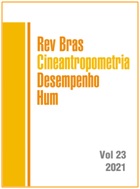Systematic review of the community environment for physical activity in young people - an update to the Report Card Brazil
DOI:
https://doi.org/10.1590/1980-0037.2021v23e83464Abstract
The aim of this study was to update a systematic review on the relationship between the environment and physical activity among Brazilian children and adolescents. The search for articles for this review was performed in the MEDLINE, LILACS / BIREME, and SCIELO databases. For this update, only articles published in 2018 and 2019 were used. Descriptors were defined in English and Portuguese. The Boolean used for the advanced search was used, with 3 main blocks: environment, physical activity, and population. Additional filters were used ??in accordance with the structure of a database. In all, 5 articles were included in this systematic review, 4 with a population-based sample and 1 with a school-based sample. Among the selected studies, 4 were carried out in the southern region of Brazil (2 in Santa Catarina; 1 in Rio Grande do Sul; 1 in Paraná) and the other article was carried out with a national sample. The research period ranged between 2012 and 2017, with a sample size ranging from 38 volunteers to 102,072 participants. The environmental indicators found were road safety, the existence and use of spaces for the practice of physical activity, the characteristics of the school, and the possibility of practice in the school environment. It was concluded that environmental indicators can enhance the practice of physical activity among young Brazilians, requiring public policies that develop environmental projects to promote physical activity.
References
Guthold R, Stevens GA, Riley LM, Bull FC. Worldwide trends in insufficient physical activity from 2001 to 2016: a pooled analysis of 358 population-based surveys with 1•9 million participants. Lancet Glob Health 2018;6(10):e1077-e1086. doi: 10.1016/S2214-109X(18)30357-7.
World Health Organization (WHO). Guidelines on physical activity and sedentary behaviour. Geneva; 2020
Lobstein T, Jackson-Leach R, Moodie ML, Hall KD, Gortmaker SL, Swinburn BA, James WPT, Wang Y, McPherson K. Child and adolescent obesity: part of a bigger picture. Lancet 2015;385:2510–20
Marzi I, Demetriou Y, Reimers AK. Social and physical environmental correlates of independent mobility in children: a systematic review taking sex/gender differences into account. Int J Health Geogr 2018;17(1):24.
Silva ICM, Hino AA, Lopes A, Ekelund U, Brage S, Gonçalves H, Menezes AB, Reis RS, Hallal PC. Built environment and physical activity: domain- and activity-specific associations among Brazilian adolescents. BMC Public Health 2017;17(1):616.
Sallis JF, Cervero RB, Ascher W, Henderson KA, Kraft MK, Kerr J. An ecological approach to creating active living communities. Annu Rev Public Health 2006;27:297-322.
Manta SW, Silva KS, Minatto G, Lopes MVV, Mello GT, Filho VCB. Community and environment for physical activity among young people: a systematic review of the Report Card Brazil 2018. Rev Bras Cineantropom Desempenho Hum 2018;20(4): 543-562.
Sallis JF, Cerin E, Conway TL, Adams MA, Frank LD, Pratt M, et al. Physical activity in relation to urban environments in 14 cities worldwide: a cross-sectional study. Lancet 2016;387(10034):2207-17.
Smith M. Systematic Review Protocol. figshare. 2017. Retrieved September 26, 2017
EndNote [http://endnote.com/.In]
National Heart, Lung and Blood Institute. Quality assessment tool for observational cohort and cross-sectional studies. Bethesda: National Institutes of Health, Department of Health and Human Services. 2014
Tan SS, Goonawardene N. Internet Health Information Seeking and the Patient Physician Relationship: A Systematic Review. J Med Internet Res 2017;19(1):e9
Higgins JP, Thompson SG, Deeks JJ, Altman DG. Measuring inconsistency in meta-analyses. BMJ 2003; 327(7414): 557-60.
Dias AF, Gaya AR, Brand C, Pizarro AI, Fochesatto CF, Mendes TM, et al. Distance from home to the nearest park and the use of the parks for physical activity: the mediator role of road safety perception in adolescents. Public Health 2019 Mar;168:9-16.
Rossi CE, Correa EN, Neves JD, Gabriel CG, Benedet J, Rech CR, et al. Body mass index and association with use of and distance from places for physical activity and active leisure among schoolchildren in Brazil. Cross-sectional study. Sao Paulo Med J 2018;136(3):228-236.
Camargo EM de, Alberico CO, Lopes AAS, Schipperijn J, Reis RS. Characteristics of the built environment on GPS-determined bicycle routes used by adolescents . Rev Bras Ativ Fís Saúde 2019; 24:1-7.
Prado CV, Junior JCF, Czestschuk B, Hino AAF, Reis RS. Physical activity opportunities in public and private schools from Curitiba, Brazil. Rev Bras Cineantropom Desempenho Hum 2018; 20(3); 290-299.
Oliveira MGD, Araújo RHO, Couto JO, Santos AE, Santos JR, Batista KRO, et al. School environment and practice of accumulated physical activity in young Brazilian students. Rev Bras Cineantropom Desempenho Hum 2018, 20(4). 563-573.
Sidone OJG, Haddad EA, Mena-Chalco JP. A ciência nas regiões brasileiras: evolução da produção e das redes de colaboração científica. Transinformação 2016; 28(1);15-32.
Smith M, Hosking J, Woodward A, Witten K, MacMillan A, Field A, et al. Systematic literature review of built environment effects on physical activity and active transport - an update and new findings on health equity. Int J Behav Nutr Phys Act 2017;14(1):158.
Barrett-Williams SL, Franks P, Kay C, Meyer A, Cornett K, Mosier B. Bridging Public Health and Education: Results of a School-Based Physical Activity Program to Increase Student Fitness. Public Health Rep 2017;132(suppl 2):81S-87S.



